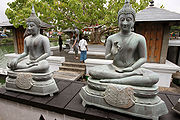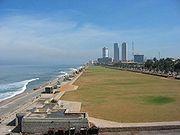|
|
|
| |
| |
| |
 |
About Colombo |
|
|
| |
Colombo (Sinhala: ????, pronounced ['kol?mb?]; Tamil: ????????) is the largest city and commercial capital of Sri Lanka. It is located on the west coast of the island and adjacent to Sri Jayawardenepura Kotte, the capital city of Sri Lanka. Colombo is a busy and vibrant city with a mixture of modern life and colonial buildings and ruins[2] and a city population of 647,100.[1] The Colombo Metropolitan Region, defined by the districts of Colombo, Gampaha and Kalutara, has an estimated population of 5,648,000, and covers an area of 3,694.20 kmē.[3][4]
Due to its large harbour and its strategic position along the East-West sea trade routes, Colombo was known to ancient traders 2,000 years ago. However it was only made the capital of the island when Sri Lanka was ceded to the British Empire in 1815,[5] and its status as capital was retained when the nation became independent in 1948. In 1978, when administrative functions were moved to Sri Jayawardenepura Kotte, Colombo was designated as the commercial capital of Sri Lanka.
Like many cities, Colombo's urban area extends well beyond the boundaries of a single local authority, encompassing other Municipal and Urban Councils. The main city is home to a majority of the Sri Lanka's corporate offices, restaurants and entertainment venues.[6] Famous landmarks in Colombo include the Galle Face Green, the Viharamahadevi Park as well as the National Museum. |
.jpg) |
|
| |
History
As Colombo possesses a natural harbour, it was known to Romans, Arabs, and Chinese traders over 2,000 years ago. Traveller Ibn Batuta who visited the island in the 14th century, referred to it as Kalanpu.[9] Arab Muslims whose prime interests were trade, began to settle in Colombo around the 8th century AD mostly because the port helped their business and controlled much of the trade between the Sinhalese kingdoms and the outside world. Their descendants now comprise the local Sri Lankan Moor community.[5][10] |
 |
|
| |
Reconstruction and Developments
The great majority of Sri Lankan corporations have their head offices in Colombo. Some of the industries include chemicals, textiles, glass, cement, leather goods, furniture, and jewellery. In the city centre is located South Asia's second tallest building - The World Trade Centre. The 40 story Twin Tower complex is the centre of important commercial establishments, situated in the Fort district, the city's nerve center. Right outside the Fort area is Pettah which is derived from the Sinhalese word pita which means out or outside as it is outside the Fort.[citation needed]
Pettah is more crowded than the fort area. Pettah's roads are always packed and pavements are full of small stalls selling from delicious Sherbat to Shirts. Main Street consists mostly of clothes shops and the cross roads, which are literally known as Cross Streets where each of the five streets specializes in a specific business. For example the First Cross Street is mostly electronic goods shops, the Second, cellular phones and fancy goods. Most of these businesses in Pettah are dominated by Muslim traders. At the end of the main street further away from Fort is the Sea Street, Sri Lanka's Gold market - dominated by Tamil interests. This mile-long street is full of jewellery shops.[citation needed]
The Colombo Metropolitan Region (CMR) encompasses the country's administrative capital Kotte and Colombo. Found within the borders of the CMR is 80% of the country's industries and over 60% of all vehicles plying Sri Lankan roads.[citation needed]
At one time Air Lanka (now SriLankan Airlines) had its head office in Colombo.[30] |
 |
|
| |
|
| |
|
|
|
|
|
|
|
| |
|